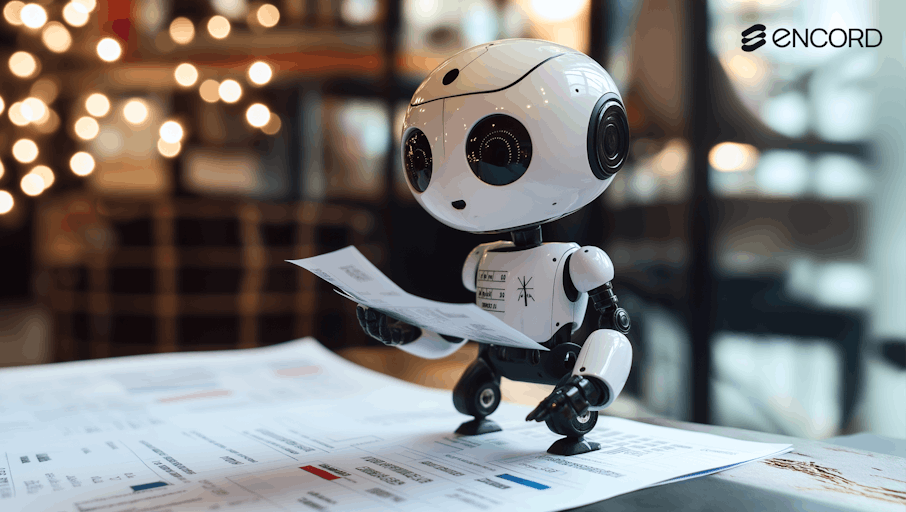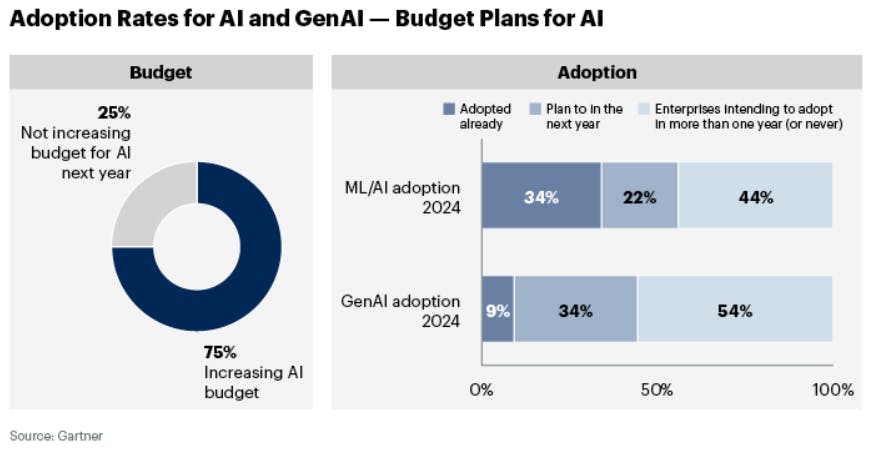Contents
AI & ML Market Statistics
AI & ML Adoption
AI & ML Benefits
AI & ML Sentiments
AI & ML Impact on the Workforce
AI & ML Tools
Top AI Trends
AI & ML Trends: Key Takeaways
Encord Blog
Machine Learning Trends & Stats for 2024

The world is witnessing exponential advancements in artificial intelligence and machine learning technologies. These developments are introducing advanced tools and frameworks that are revolutionizing human-machine interactions like never before.
Businesses are quickly integrating AI to boost productivity and reduce costs. In fact, 83% of companies consider AI a top strategic priority.
In this article, we will explore key trends and statistics to help you learn more about recent developments in AI.
AI & ML Market Statistics
- The global AI market was worth $196.63 billion as of 2024 and is projected to grow at a CAGR of 28.46% between 2024 and 2030.
- Estimates suggest that by 2030, AI will contribute around $15.7 trillion to the global economy - more than India and China’s current GDP.
- The computer vision market was worth $20.31 billion in 2023, with a projected CAGR of 27.3% between 2023 and 2032.
- The estimated size of the natural language processing (NLP) market is projected to reach $31.76 billion by the end of 2024, with a CAGR of 23.97% between 2024 and 2029.
- The large language model (LLM) market is currently valued at $6.4 billion and is expected to reach $36.1 billion by 2030, growing at a CAGR of 33.2% between 2023 and 2030.
AI & ML Adoption
- Over 50% of companies in the U.S. with more than 5,000 employees use AI.
- Chinese and Indian companies report the highest use of AI compared to other developed countries, with 60% of IT professionals saying they already use AI applications.
- Over 20% of American content creators used AI to generate videos and images in 2023.
- Due to labor shortages, around 25% of companies are adopting AI to enhance business operations globally.
- According to the latest online survey by Gartner that covered CIOs from multiple geographies and industries, 34% say they already adopted AI, while 22% say they will do so by the end of 2024.

- Around three in four CIOs across multiple industries globally intend to boost investment in IT services and AI-powered and AI-augmented applications.
- Insurance companies have the highest AI adoption rate of 49%, followed by U.S. healthcare companies, which have an adoption rate of 48%.
- U.S. healthcare companies also have the most aggressive spending budget for AI.
- 48% of businesses use deep learning, NLP, and ML models to manage large datasets. Organizations surveyed worked in software, consulting, finance, healthcare, government, higher education, telecommunications verticals among others.
AI & ML Benefits
- According to a global survey by McKinsey, generative AI increased revenue by 5% in 2023 in supply chain and inventory management.
- 38% of businesses achieved cost reduction through machine learning technologies.
- According to research by Gartner, quick product development, enhanced customer experience, and greater workforce productivity are the most significant benefits of Gen AI.
- Netflix’s AI-based recommendation algorithm saves the company $1 billion annually.
- Companies that lead in AI functionalities produce total shareholder returns (TSR) four to six times higher than organizations that lag in AI investments. This trend is consistent across various industries, such as insurance, banking, and retail.

TSR Returns - Leaders versus Laggards
- Amazon’s revenue from AWS increased by 17% to $25 billion in 2024. The company chief executive believes the performance is a result of continued focus on AI.
AI & ML Sentiments
- 44% of business owners feel AI helps them with better decision-making.
- 64% of business owners believe AI will improve customer relationships.
- Globally, only 54% of consumers think that AI-based products have more benefits than drawbacks.
- Only 49% of consumers surveyed across 31 countries say AI changed their lives in the past 3 to 5 years.
- 57% of workers believe AI will change how they do their jobs and 36% feel AI will replace them.
AI & ML Impact on the Workforce
- AI automation is projected toreplace around 400 million workers by 2030, resulting in a 15% job loss globally.
- On the other hand, AI will create around 97 million new jobs. These jobs include developers and engineers who work on LLMs, UX designers, and content creators. Demand for LLM developers will increase as more technologies become dependent on tools such as ChatGPT. Demand for UX designers will increase to create intuitive interfaces to help users interact with AI. Demand for content creators will increase due to the need for relevant prompt engineering to generate the desired content.
- AI models will increase labor productivity by 40% across sixteen industries by 2035.
- A recent survey shows that 39% of chief data officers implemented AI literacy programs to fill these crucial roles. Must-have AI roles include prompt, data, and machine learning engineers, data scientists, AI ethicists, heads of AI, and data and analytics translators.

- According to Gartner, Gen AI will augment the human workforce in 90% of companies globally by 2025.
- Significant workforce reskilling is necessary to increase AI adoption. A recent report by Statista suggests that around20% or more enterprise employees will need reskilling.
AI & ML Tools
- End-user spending on Robotics Process Automation (RPA) tools reached $3.35 million in 2023, up 17.5% from the previous year.

- According to the 2024 Gartner Magic Quadrant, Microsoft, Google, and Oracle are the leaders in analytics and business intelligence (BI) platforms.
- 48% of businesses in software and professional services use ML, data analysis, and other AI tools to ensure accurate and error-free data.
- Listings of AI software providers on Gartner Digital Markets doubled in 2023, with AI product reviews increasing by 2.5 times.
- 92% of organizations plan to invest in AI tools such as chatbots in 2024, believing such solutions offer significant productivity and time-saving benefits.
Top AI Trends
Now, let's dive into the key trends that will shape the future of AI in the coming years.
Cloud Systems
Due to the scalability and flexibility of cloud-based AI ecosystems, many organizations are moving from stand-alone software applications to cloud-native solutions.
According to Gartner, 50% of new system deployments will occur in the cloud instead of separate point solutions requiring manual integration.
The shift toward hybrid and cloud-based solutions will make AI more accessible to startups and small-to-medium enterprises (SMEs) that lack sufficient funds to build in-house platforms.
Organizations will benefit from the cloud’s low latency and high throughput, as cloud-based platforms have integrated GPUs to optimize AI models.
Edge AI
The need to process data at the point of generation is increasing as organizations prioritize real-time insights and compliance with data privacy regulations. Gartner predicts that over 55% of deep neural networks will analyze data at the source by 2025.
Businesses can identify deeper patterns by processing data at the source and deploying AI algorithms on local devices. These include sensors, cameras, and other Internet-of-things (IoT) devices.
In addition, edge AI allows businesses to streamline AI deployment through seamless integration and orchestration of AI workflows, helping them create more advanced AI models.
Generative AI
Gen AI is reshaping how personal and business users interact with AI to perform multiple tasks. According to the latest McKinsey survey, 65% of organizations use Gen AI, and 75% of respondents expect the technology to result in disruptive change.

Respondent’s Use of Gen AI by Function
The survey reports that sales and marketing, service development, and IT functions are the most prominent areas where organizations deploy Gen AI technologies. Further, Gartner reports that 38% of executives invest in Gen AI to improve customer experience and retention, increase revenue, and reduce costs.
As Gen AI models become open-source, their adoption will likely soar in the near future, encouraging more businesses to implement Gen AI frameworks to solve complex issues and boost operational efficiency.
Responsible AI
As AI spreads across multiple aspects of human life, the concern for ethical AI deployments is rising. The trend involves addressing user sentiments regarding transparency, accountability, risk, trust, and societal value associated with AI initiatives.
With only 1% of AI vendors owing large pre-trained models, the need for responsible AI is rapidly increasing. As such, organizations should adopt best practices for managing risk and preventing bias when building frameworks using these pre-trained models.
Data-centric AI
Data-centric AI is focuses on building frameworks that ensure data is clean, accurate, and consistent rather than just improving algorithms. This approach helps create platforms that enable users to quickly pre-process, curate, and label datasets with AI-based models, automating the entire workflow.
For instance, the Encord platform is an end-to-end solution that offers AI tools to curate and annotate image, video, and medical data. It provides micro-models that users can train on a few data samples and automatically label remaining data points for better results.
Data-centric AI also involves generating synthetic data using Gen AI tools to make up for the lack of real-world data needed for training complex CV and NLP models. According to reports, about 60% of data will be synthetic by the end of 2024.
Accelerated AI Investments
AI investments are increasing with the rise of foundation models. Gartner forecasts that around $10 billion will be spent on AI startups relying on such models. Also, around 70% of organizations are exploring Gen AI solutions, while 19% are already in the pilot phase.
The increased investment will likely result in more AI innovations in real-world applications and stronger collaboration between research institutes, corporations, and the government.
Popular Use Cases
With the increasing prevalence of mobile technology, the use of AI-based voice assistants and chatbots is increasing. Reports predict there will be around 8 billion voice assistants by the end of 2024. Moreover, the telecommunications industry is one of the most significant users of chatbots, with 52% of telecom businesses using the technology to improve productivity.

For consumers, the most popular AI use cases include:
- Responding to messages and emails,
- Answering financial questions,
- Planning travel itineraries,
- Crafting emails,
- Preparing for job interviews,
- Writing social media posts,
- Summarizing long copies
Top Picks
- Machine learning’s projected market size will reach $79.29 billion by the end of 2024.
- Global AI software spending will reach $297.9 billion by 2027.
- The ML Operations (MLOps) market is predicted to have a compound annual growth rate (CAGR) of 43.2 between 2024 and 2033.
- According to Bloomberg, generative AI (Gen AI) will be worth $1.3 trillion by 2032.
- Financial Times reports that OpenAI’s revenue surpassed $2 billion as demand for ChatGPT explodes.
- Around 92% of Fortune 500 companies are using Open AI products.
- 80% of business leaders think that Gen AI will increase efficiency.
AI & ML Trends: Key Takeaways
The above statistics and trends clearly show that organizations wishing to stay ahead of the competition must invest in AI and ML technologies to boost revenue, improve customer experience, and reduce costs.
Below are a few critical points to remember regarding AI.
- Generative AI has the Highest Adoption: Organizations are rushing to implement generative AI technologies in multiple business functions to improve operational efficiency.
- Customer Experience is Key: The motive behind significant investments in AI is to improve customer experience and relationships.
- Workforce Reskilling: Significant workforce reskilling is necessary to counter AI’s job displacement effects.
- Key Trends: The most prominent trends in 2024 are the shift to cloud systems, edge AI, and a focus on building data-centric frameworks.
References
Data infrastructure for multimodal AI
Click around the platform to see the product in action.

Written by

Frederik Hvilshøj
Explore our products
- The adoption of cloud systems, edge-based deployments, data-centric frameworks, and generative AI technologies are the top AI trends in 2024.
- AI solutions will become more accessible to the general public, and generative AI will be the key growth driver in AI-based solutions for everyday tasks.
- Users must implement robust pipelines that preprocess, curate, and annotate large datasets in real time. They can integrate these pipelines with machine learning frameworks that offer tools for training, validating, and deploying models in production.
- Edge AI will provide low-latency and high throughput pipelines for data processing and analysis, allowing faster deployments and enhanced data privacy.
- Responsible AI involves building AI systems that are non-biased, transparent, and fair. Its implementation is essential for building consumer trust in AI-based technologies across multiple domains.


